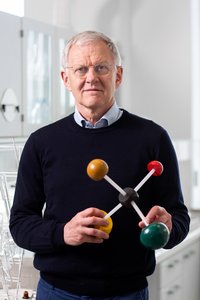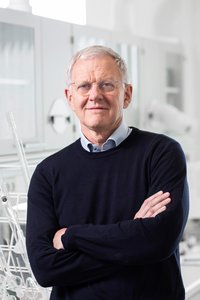- Education
-
Research
Current research
Talent
-
Collaboration
Businesses
Government agencies and institutions
Alumni
-
About AU
Organisation
Job at AU
He was declared "not suitable" for upper secondary school, but today he is one of the world's most cited chemists. What’s more, he insists on a little wildness at work. Meet Professor Karl Anker Jørgensen, who today is receiving the H.C. Ørsted Gold Medal in chemistry. The medal is being awarded for the first time in 30 years.
2019.10.11 |

Professor Karl Anker Jørgensen was previously a keen athlete at elite level, and among other things, he was the Danish national champion in 110-metre hurdles and the decathlon. "Sport has definitely been hugely important for my career. I'm a competitive person, both in sport and in pioneering research," he says. Photo: Lars Kruse

"From the moment we’re conceived to when life ends, our lives are a long series of chemical reactions controlled by enzymes, and therefore human beings are the most amazing example of chemistry," says Karl Anker Jørgensen. Photo: Lars Kruse
"Has it ever occurred to you, that when you look at yourself in a mirror, you're not really looking at yourself?" Professor Karl Anker Jørgensen smiles cheekily.
"Most people are a little shaken when they hear this. You can't rely on anything anymore," says the professor.
But it’s true enough. You actually see a mirror image of yourself. Your right hand looks like your left hand, and so on. The phenomenon is called chirality, and it is Karl Anker Jørgensen's speciality. The phenomenon that two molecules are each other's mirror image and can have vastly different properties is very useful because, with some practice in the laboratory, it is possible to control the processes so that a molecule is only formed in one mirror-image shape. It’s called asymmetrical catalysis, and it is very important, not least in the field of medicine.
Karl Anker Jørgensen sees the rare award of the H.C. Ørsted Gold Medal as enormous recognition. The medal has only been awarded 16 times since 1909, and Niels Bohr was one of the first recipients in 1924.
When he was young, it was never on the cards that Karl Anker would end up as an award-winning professor of chemistry. In fact, he was declared 'not suitable' for upper secondary school. He chose a different path to university, via a student course on which an inspirational teacher opened the young Karl Anker’s eyes to the world of chemistry.
The right chemistry
"I actually thought that I’d end up being a doctor," he says in his office on the fifth floor at the Department of Chemistry. "But I've found my place in life as a chemist. Chemistry is so fundamental. My goal is better chemistry, for example to develop more effective drugs with fewer side effects, and to reduce our impact on nature," he explains.
Karl Anker Jørgensen has developed a branch of chemistry that has found wide application in the academic world and in a number of industries, including the pharmaceutical and agrochemical industries. His research has had a very strong international impact.
A significant side of Karl Anker Jørgensen – and one of the reasons why he is receiving the H.C. Ørsted Gold Medal – is his hard work to promote interest in chemistry and science in society at large. He has held approximately 1,000 popular scientific lectures on chemistry and molecular gastronomy throughout Denmark.
"My dream is for everyone to understand just how important chemistry is. I'm often on the Formiddag radio programme on P4, where the presenter calls me ‘the Danish Broadcasting Corporation’s house chemist’. I take this as a big pat on the back. It’s important that people have basic knowledge of chemistry, so they can take a view on various aspects of the public debate. This applies in particular to politicians, who might otherwise make the wrong decisions," he says.
Washer-up for rock tour
A turning point in Karl Anker Jørgensen's career was his stay at Cornell University in the US, where Nobel Prize winner Professor Roald Hoffmann taught him about good chemistry. He had an "open-door policy" and was always there for us students. Just as importantly, the young Karl Anker learned that chemistry is more than just chemistry.
"I don't think you can be a good chemist by just sitting in an office. You have to have your antennae out in our fantastic world, so that you can develop creatively. You can’t see any chemistry books in this office, can you?”
“None at all,” I reply.
“On the other hand...” Karl Anker Jørgensen rotates excitedly on his stool and points to a 2x2-metre black painting on the opposite wall. The painting has black boxes stuck on it, and a steel wire runs carelessly through the dark colours.
"This work is by Erik A. Frandsen and some friends gave it to me. For me, it radiates wildness. When I look at it, I think, ‘Remember the wildness of youth.’"
That same wildness prompted Karl Anker Jørgensen to play loud music by Rammstein during his presentation at the Rigmor and Carl Holst-Knudsen Award for Scientific Research in 2016. "I always have to break with what’s expected," he admits. When he was younger, the professor also went on tour with the German band – as a washer-up!
64 going on 26.
"Do you want to see the lab?" Karl Anker Jørgensen jumps up from his chair, and a few seconds later we are in one of the labs. It smells a bit like a dental surgery. Young Master’s students, PhD students and postdocs in white coats and safety glasses immediately start talking to the professor.
"It's a fantastic privilege to work with young people. It’s one of the best things about my job. There’s nothing better than when one of the young researchers comes in here and fills the board with formulas. Most of the PhD students are around 25 years old. I still feel like I'm 25 when I’m with them. Well, perhaps going on 26 now," adds Karl Anker Jørgensen with a grin.
His job is to provide the best possible framework for the young researchers. It is also important for him to teach the young people that chemistry is fun. And that they can make a difference.
"I work for the young and they work with me. I'm here for their sake."
Chemical connection to H.C. Ørsted
Karl Anker Jørgensen sees H.C. Ørsted, the man who gave his name to the medal he is about to receive, as an important role model. In addition to being an outstanding scientist who discovered electromagnetism, H.C. Ørsted was concerned about communicating the natural sciences, and he founded the Society for the Dissemination of Natural Science. Moreover, the physicist was interested in art and culture, and he was close friends with important cultural figures such as H.C. Andersen and Adam Oehlenschläger.
"Perhaps there was a cross-over effect. Perhaps H.C. Ørsted was inspired by the cultural perspective in his academic achievements. I definitely feel an invisible chemical bond to H.C. Ørsted.”
Professor Karl Anker Jørgensen
H.C. Ørsted Gold Medal in Chemistry
The H.C. Ørsted Medal is awarded for outstanding scientific work in the fields of physics and chemistry. Behind the medal are the Society for the Dissemination of Natural Science, the Royal Danish Academy of Sciences and Letters and the Ørsted company. Among other things, the collaboration focuses on promoting communication of science and technology to the Danish population. The Gold Medal and the award was presented by Her Majesty the Queen at the Royal Danish Academy of Sciences and Letters on 16 October 2019.